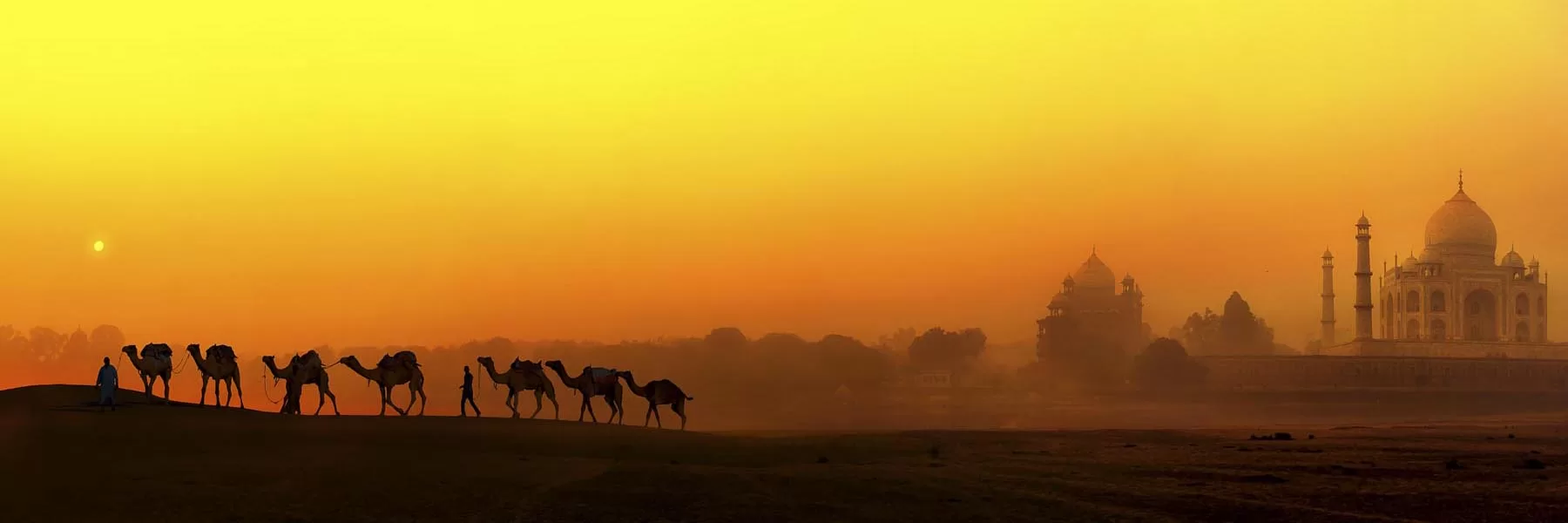One amongst the seven wonders of the world, The Taj Mahal, is a mesmerizing sight that is bound to take away the hearts of anyone who even takes a look at the masterpiece that it is. This enormous mausoleum of white marble was built by the order of emperor Shah Jahan in the memory of his beloved wife, Mumtaz Mahal. The Taj Mahal stands as the pride of the Indian Sub-Continent and a symbol of eternal love. Built at the banks of the river Yamuna, the Taj Mahal is built in a garden that encompasses around 42 Acres (17 hectares) of land and adorns mesmerizing architectural details that will leave you spellbound.
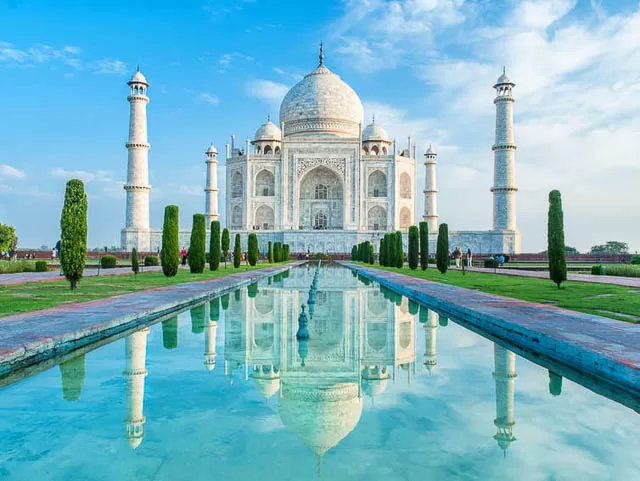
Classic view of Taj
History of construction of The Taj Mahal:
An iconic destination for millions of guests around the world, the Taj Mahal is considered Mughal architecture’s finest construction in the world. This complex was designated a UNESCO World Heritage Site in 1983. To immortalize his favorite wife, Mumtaz Mahal, who passed away in childbirth in 1631, this historic monument was built by the then king of the Mughal Empire, Shah Jahan with its construction starting from 1632 AD and ending in 1648 AD. Located in the beautiful Agra district in Uttar Pradesh, other than the enormous Mausoleum and its four minarets, the complex also has a mosque, a guest house right opposite to the mosque, a huge gateway, and a vast garden which was all designed and planned as a single project.
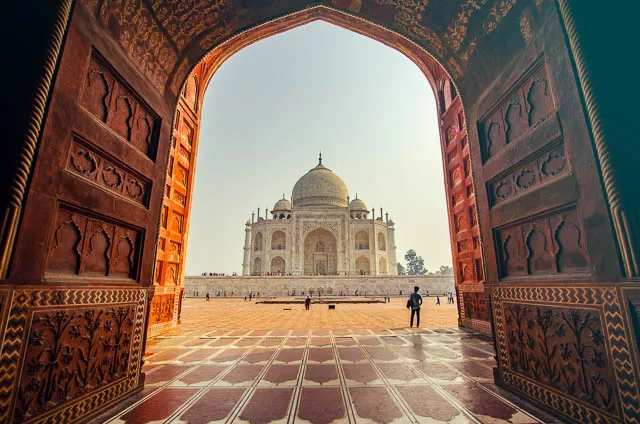
Taj from the entry gate
The construction plans for the Taj Mahal were worked on with several architects. One of them known to be the chief architect of this masterpiece was an Indian of Persian descent, Ustad Ahmad Lahawri. Over 20,000 workers were brought in from India, Persia, Europe, and the Ottoman Empire to complete the construction, who were assisted by over 1,000 elephants. And this employment of workers went on until 1639, just for the Mausoleum. The other buildings were finished in 1643 and decoration work went on until 1647.
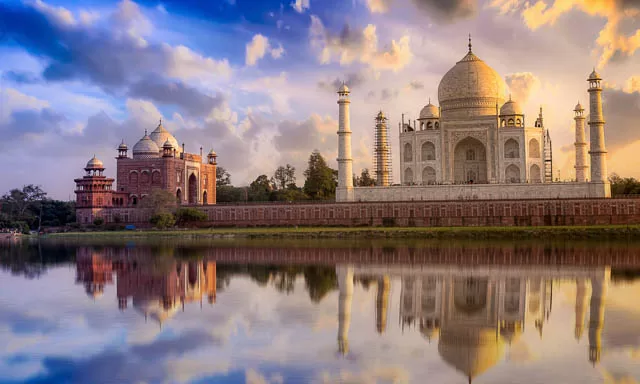
Taj as seen from back side
The whole construction of the mausoleum complex that was influenced by Indian, Islamic and Persian styles and completed giving utmost detail to attention not just in the decoration but also the construction itself, went on for over the time-span of 22 years.
Layout and Architecture of the Taj Mahal:
- The white marble mausoleum:
The mausoleum itself rests in the center of a wide plinth, at a height of 23 feet. This white marble monument is said to change hues as it reflects sunlight and moonlight, throughout the day and night. Four almost identical facades with a central arch that has a height of 108 feet and housing smaller arches in the corners are a rather noticeable part of the mausoleum’s architecture. The majestic dome at the center is 240 feet high at the finial’s tip and is surrounded by four smaller domes on all four corners. The interior itself is constructed in such a way that it surrounds an octagonal chamber made of marble and detailed with beautiful semi-precious stones and low-relief carvings, where the cenotaphs of Mumtaz Mahal and the emperor himself, Shah Jahan are present. A marble screen covers these false tombs, beneath which the true sarcophagi lie.
- Minarets and the identical structures:
Four minarets stand elegantly, away in equal spaces on the four corners from the central unit itself, and have a beautiful existence of their own. Aesthetic balance is rendered by the identical buildings that stand adorning different textures and colors of the mausoleum itself, on the northwestern and northeastern ends of the garden. These are the Mosque and its Jawab, which face the east and the west respectively.
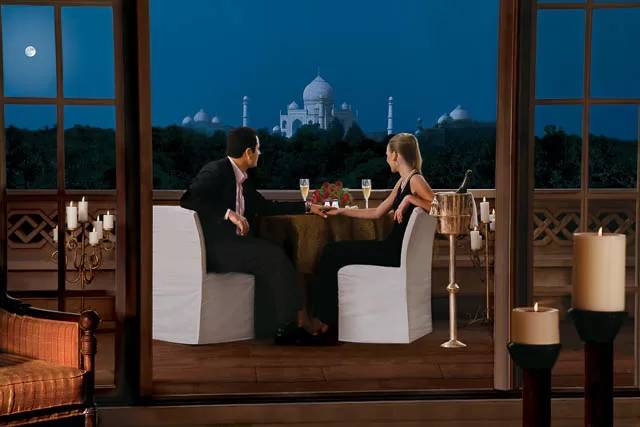
Taj as seen from Amarvilas
- The gateway:
A red sandstone gateway that has a recessed central arch which is two stories high, graces the southern end of the complex. Flanked by two smaller arches, the main arch has white marble paneling running around it, inlaid with Quranic letterings in black and decorated with floral designs. Rows of white cupola-like structures called the “chhatris”, (11 on top of each façade) sit atop the northern and southern facades of this gateway. Along with these, there are thin ornamental minarets as high as 98 feet tall. Larger Chhatris are placed over the octagonal towers that are present on four corners of the gateway.
- Calligraphy and inscriptions:
Pietra dura and Arabic calligraphy are the two most noticeable decorative details repeated in various elements of the whole mausoleum complex. Several colorful semiprecious stones are used to decorate the pietra dura in intertwining geometric and floral designs. Few of them being jade, crystal, lapis lazuli, turquoise, and amethyst, which serve to balance out the white Makrana marble’s effect.
The arched entrances of the complex also are beautifully designed with calligraphy, which has a slight increase in the size based on its height from where the viewer stands, to allow a clearer view. Other than the entrance, the Taj Mahal has inscriptions and calligraphy that contains Quranic verses, known to be inscribed under Amanat Khan al-Shirazi’s direction, in several of its sections.

Inscriptions on the Taj
Current State and Issues of the Taj Mahal:
Being a place of public tourism for several million guests each year and being subjected to the weather, pollution, and various other challenges over the years, the Taj Mahal has faced decay and loss. While a restoration did take place in the 20th century, under India’s British Viceroy, Lord Curzon’s direction, in a colonial effort to preserve the cultural and artistic heritage of India, the Taj Mahal has post-restoration, faced a continual threat due to the emissions and pollution of factories and automobiles, that pose a fear of more damage, especially to the white marble. Several precautions have been taken ever since and so, in 1998, a restoration and research program was initiated keeping the same in mind. However, the progress is evidently slow in this and there is still quite a fear of losing the natural charisma of the monument even more than we already have.
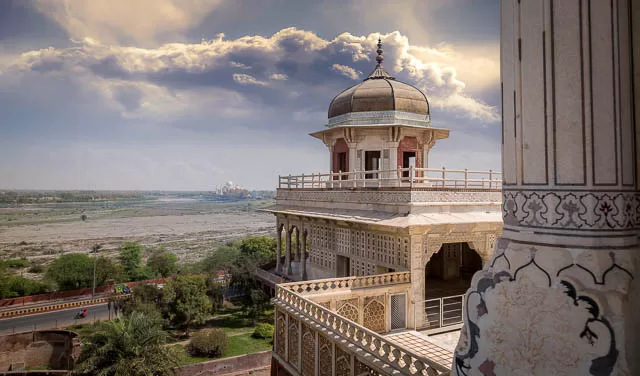
Taj Mahal as seen from Agra fort
Amidst all the efforts and plans executed to restore the splendid monument’s beauty how much ever possible, several political and religious dynamics have come into play which threatens the diminishing of the Islamic influences on the design, carvings, and ultimately, the soul of this world heritage site itself.
India has been blessed with several astonishingly beautiful monuments, but the Taj Mahal always has and still stands as the most stunning place that symbolizes India’s rich history and cultural and artistic heritage. It is the monument that makes every Indian proud as it stands strongly, reflecting the beauty in and around it through its beautiful white marble exterior. A paradise for the art and architecture lovers, the Taj Mahal leaves everyone who visits it, deeply mesmerized with the attention to detail and peaceful aura that it adorns
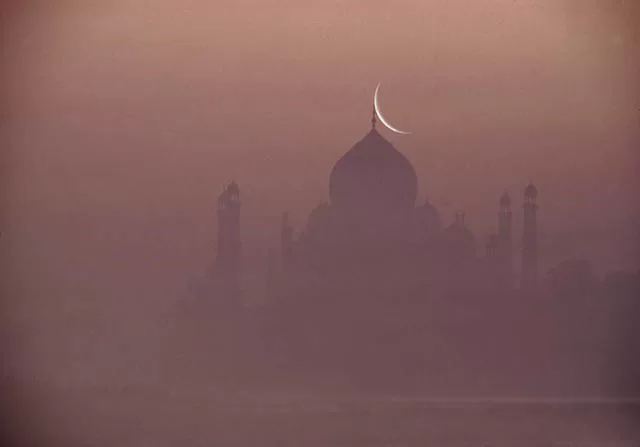
Taj by the master photographer Raghu Rai
If you loved reading this story, then subscribe to our blog here (it will ask to verify your email) to get inspiring travel stories and trivia delivered to your email. Stories about wildlife trivia, cultural experiences, curated luxury hotel lists, underrated places to travel, polar journeys and much more.


